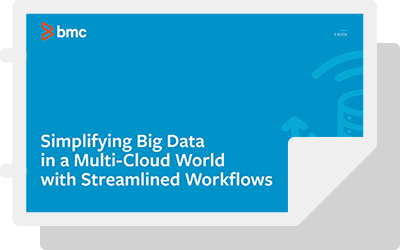At BMC, we spend lot of time talking with our financial services customers about their strategic initiatives. Customers had different challenges on their path to fulfilling their strategic initiatives, but their approach to solving their challenges were similar, and fit into one of three categories. Some financial services companies focus on incremental digital improvements to existing operating processes and business models (digital optimizers). Others embrace radical digital disruption to unlock new areas for growth (digital transformers). And the third category, where most companies resided, is a mix of digital optimization and transformation. And the reason most companies are doing some of both is they recognize the need to continue to run their company in the most efficient manner, while also reinventing part of their company to deliver innovation and generate growth.
Run: Continuing to run the company is quite a challenge. Just keeping the lights on in large IT estate within a highly regulated industry takes most of the budget, leaving very little to invest in innovation. Financial services need to regain a balance between core IT spending and innovation budget.
Reinvent: Much of the reinventing comes from the use of new applications. The key for success is how fast those applications can be developed and deployed. But what kind of applications are financial services companies focused on most? Two types of applications emerged as the most common answers:
- Mobile: Based on customer expectations, mobile is a top area of focus. Mobile applications represent the preferred interface, over web applications. Financial services companies need to provide secure, easy access to their customers, regardless of their location, time of day or service they want to access. Mobile services are fundamental to success and a requirement to improve the customer experience.
- Analytics: data analytics topped the list of differentiating technologies. According to McKinsey, companies that are more analytically driven realize financial growth three times higher than their less analytical competitors.
In this article you’ll read about three use cases describing how financial services companies meet the challenge of running and reinventing their business.
USE CASES
1. Turning to cloud while keeping business applications governance
Challenges and Pains
To optimize running costs and focus on innovation, one of the largest financial services companies in the United States is turning to Amazon cloud. In four years they will reduce their data centers from 8 to 3. Not only will they save 90% of IT costs, which will be redirected into new mobile business applications, but they will be better equipped for digital business.
However, a new challenge emerges that is specific to hybrid architectures: how to interconnect business applications workflows when a portion of the workflow has been migrated from on-premise to cloud. Fragmented workflows break applications visibility and control. That comes with a series of negative implications, from loss of impact analysis and time-consuming problem determination, to SLAs breaches, to difficult auditing and reporting.
The solution
Control-M helps eliminate those problems. Control-M performance is not affected when moving applications workflows steps across different infrastructures. Visibility and control are kept. Financial services can continue to scale and bridge applications and data management across on-premise and cloud, maintain SLAs applications needed to adhere to, keep logs and outputs for auditing purposes.
The benefits in summary:
- End-to-end workflow integration, mainframe to cloud
- SLA management with proactive analysis
- Auditing for compliance and governance
2. Introducing mobile applications 60% faster
Challenges and Pains
As outlined above, delivering mobile applications is essential for financial services companies reinvent the customer experience, helping retain existing customers and attract new one.
A bank/insurance company/investment company in the Unites States adopts Docker containerization for their application packaging, and Kubernetes to manage and orchestrate containerized applications. The intent is to free up their 100+ developers by environment-specific issues and let them focus on the mobile application code.
But the company business applications are very complex, and not all the steps in their workflow are containerized Docker applications. There are other infrastructure applications and data that cannot be orchestrated with Kubernetes.
Therefore, when it was time to build up and test the broad application, developers compensated for the lack of integration and orchestration with their own scripting or CI/CD tools stretching.
Not only they were distracted from their primary business, but what they got required additional reworking time and effort to be production-ready and compliant. As a result, application delivery slowed down.
The solution
With Control-M, developers can easily access, in their own development environment, Automation API and orchestrate all the steps making up the business application workflow, including Docker, Kubernetes and other infrastructures. They can build production-ready applications, and perform exhaustive testing, similar to production testing.
The result is that development and testing activities are faster, and the application delivery is accelerated by 60%. Also, because testing is performed earlier in the application lifecycle, the application quality is higher, and the downtime is reduced.
The benefits in summary:
- End-to-end orchestration capabilities available in the development environment
- Application delivery accelerated by 60%
- Higher quality
3. Bringing relief to complexity of analytics scenarios
To enhance their leadership in customer satisfaction, one of the leading banks in Latin America runs multiple analytic scenarios, including CRM campaigns, credit and market risk, telemetries, audit and frauds.
The technology they adopted is a combination of Hadoop, Cassandra and Spark. On top of Hadoop, they built hundreds of routines, mostly Hive, Sqoop and Beeline routines, which have been growing 20% every year.
When it was time to tie everything together, they ran into multiple problems.
First, additional work was needed, consuming development time. Coding was needed not only to integrate data pipelines, but also to encrypt passwords in Hadoop scripts, validate routines, and integrate with external ticketing systems.
Also, the problem determination was very difficult. When a problem occurred, a big deal of communication was triggered to find out which was the failing routine, as the root cause and the error log were not available to the team.
The resolution
Control-M was the missing piece in the puzzle.
Leveraging Control-M, the company has automated and orchestrated the data pipeline, with native end-to-end interoperability among data sources, ETL, data lakes, BI. All the manual work for password encryption, routine validation and ticketing integration has been eliminated by built-in capabilities. Estimated cost saving is $470K per year.
Furthermore, fault detection is a lot easier and the medium time to repair is reduced by 65%. Control-M provides runtime preview in percentage bars and allows to visualize errors. Logs are available to the team and remedial actions can be immediately taken.
The benefits in summary:
- Standardized and repeatable data pipeline management
- $470K cost saving per year
- MTTR reduced by 65%
Conclusion
Financial services companies face a dual challenge. On the one hand, they want to make sure the core business system is maintained at a reasonable cost. On the other hand, they are competing with nimble startups who threaten their market share and profitability.
The above scenarios prove that Control-M helps address these two contrasting forces. It allows digital optimizers to keep application governance while they move to cloud. And it helps digital transformers get their applications ready for production faster. This is especially valuable for mobile and analytics applications, on which financial services companies focus most, as they represent an opportunity to rethink the customer experience, compliance and risk management, and respond to shifts in people’s behaviors and consumers’ demands.







